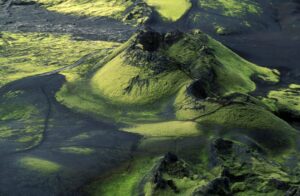This tsunami, with a wave height of one hundred feet, was triggered by an underwater earthquake of magnitude 8.1.
On the first of April 1946 Alaska experienced one of its greatest tsunamis, triggered by an earthquake of magnitude 8.1 near Unimak Island in the Aleutian Island Chain. This tsunami carried a wave height exceeding one hundred feet. It completely destroyed the U.S. Coast Guard’s Scotch Cap lighthouse on Unimak and killed all five of its occupants. The lighthouse was a steel-reinforced concrete structure standing about ninety-five feet above sea level.
The tsunami reached the Hawaiian Islands five hours later, causing considerable damage and loss of life. Hilo’s waterfront on the island of Hawaii was completely obliterated and 159 people lost the lives there. Another six were killed in other parts of Hawaii. Total damage was estimated at $26 million and, two years later, the United States established a Pacific Tsunami Warning Center in Hawaii.
During the quake, a large section of seafloor was uplifted along the fault where the quake occurred, producing a large, Pacific-wide tsunami. The most detailed and documented accounts of the tsunami come from Scotch Cap, located on Unimak Island, and the Hawaiian Islands. The tsunami had little effect on the Alaskan mainland, due to the presence of the Aleutian Islands, which absorbed the brunt of the tsunami’s power.
The effects of the tsunami were felt along the west coast of the United States, in Washington, Oregon, and California. Oregon reported a ten-foot wave. In California, Fort Bragg reported five- to nine-foot waves. One person drowned as a result of the ten-foot waves that struck Santa Cruz. The tsunami was also noticed in Santa Barbara and the greater Los Angeles area. The tsunami crossed the Pacific, producing waves up to thirty feet high in French Polynesia. It also damaged fishing boats in Chile.
A mystery surrounded this earthquake for a time. It got more and more puzzling as a seafloor search failed to reveal what scientists expected to find. The earthquake seemed too small to spawn the huge local wave and scientists struggled for decades to figure out what happened. The leading theory was that the earthquake triggered an underwater landslide and the landslide gave rise to the big tsunami but a seafloor-mapping project by Scripps Institution of Oceanography, designed specifically to look for the cause of the tsunami, didn’t find evidence to support that theory.
Researchers did see colorful corals and an unusual methane seep teaming with marine life, but the sea floor looked as if it had been undisturbed for millennia. A long-simmering scientific debate continues over just what caused the 1946 tsunami. Generation by one or more major earthquake triggered submarine landslides near the shelf edge south of Unimak Island seems to be the only viable mechanism to account for the data on wave arrival time, run-up heights, and the distribution of tsunamis across the Pacific.





















